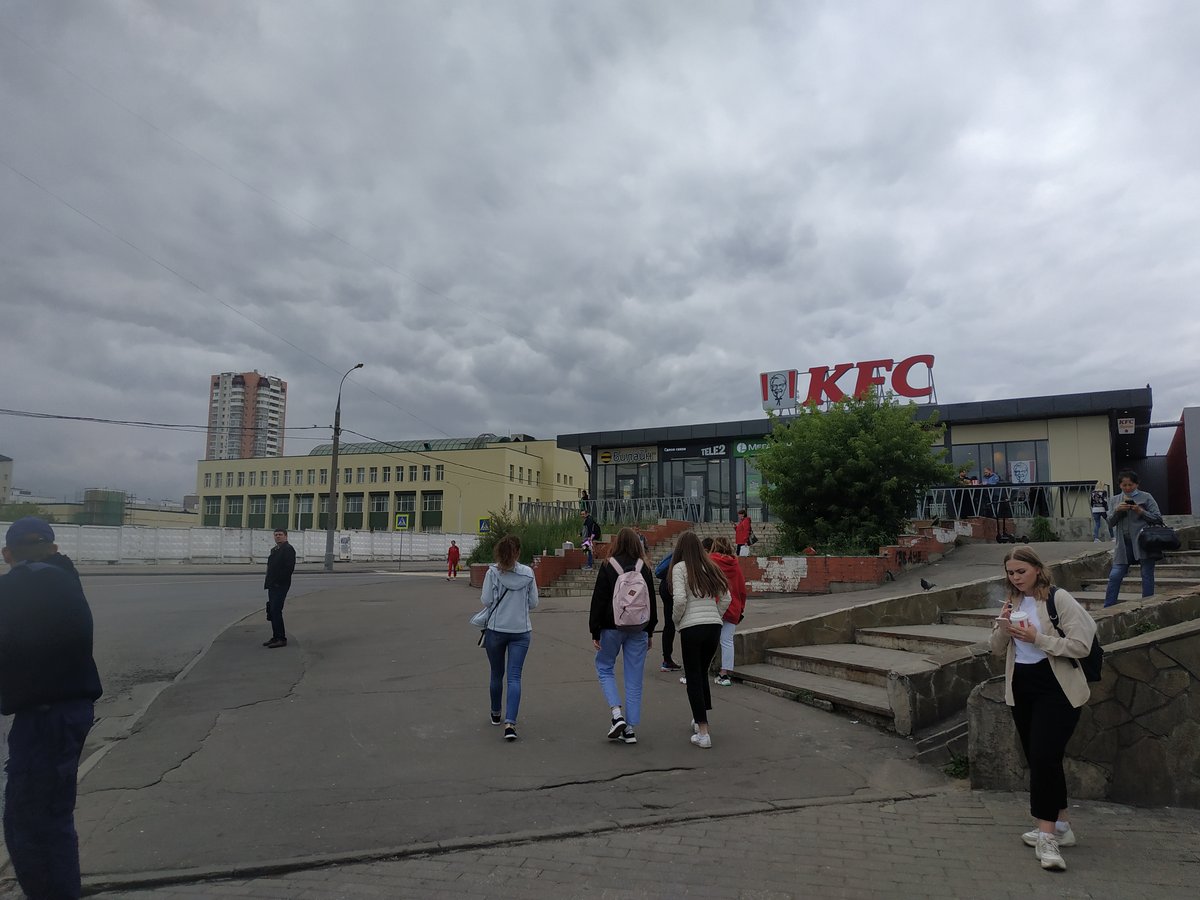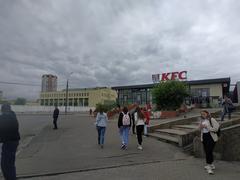
Vykhino Moscow Visiting Hours, Tickets, and Historical Sites Guide
Date: 14/06/2025
Introduction to Vykhino: History, Culture, and Visitor Experience
Located in Moscow’s southeastern district, Vykhino offers an authentic window into the city’s transformation from rural village to bustling urban hub. Originally a separate settlement dating back to at least the 17th century, Vykhino’s name—stemming from the Russian “vykhod” (exit or outlet)—reflects its historical function as a gateway between Moscow and its surrounding countryside (Russia Beyond). Its integration into Moscow’s urban network began in the Soviet era, especially with the expansion of infrastructure and the construction of the pivotal Vykhino Metro Station (Wikipedia: History of Moscow). Today, Vykhino boasts a dynamic blend of Soviet-era architecture, revitalized public spaces, and vibrant community life, providing visitors with a distinctive perspective beyond Moscow’s historic core (Moscow Seasons; Wikipedia).
This comprehensive guide covers Vykhino’s history, cultural significance, urban development, visitor information, transportation, and key attractions—including practical travel tips and details about the Vykhino Monument and Metro Station.
Contents
- Introduction
- Origins and Early Development
- Soviet Incorporation and Urbanization
- Soviet-Era Transformations
- Community Life and Cultural Significance
- Recent Modernization and Notable Events
- Visitor Information: Getting to Vykhino and Exploring the District
- Transport and Accessibility
- Parks, Markets, and Photo Spots
- Local Events and Guided Tours
- Practical Visitor Tips
- Urban Renewal and Environmental Initiatives
- Social Infrastructure and Cultural Attractions
- Main Public Spaces and Recreation
- Future Projects and District Developments
- Vykhino Metro Station: Visiting Hours, Tickets, and Architecture
- Accessibility and Multimodal Connections
- Nearby Attractions
- FAQs
- The Vykhino Monument: History, Visiting Information, and Nearby Points of Interest
- Summary and Visitor Recommendations
- Sources and Further Reading
Origins and Early Development
Historically, Vykhino originated as a small agricultural village on the outskirts of Moscow. With records dating back to at least the 17th century, it served as a waypoint for travelers moving between the city and the Ryazan region. For centuries, Vykhino’s rural landscape was defined by wooden houses and open fields—a stark contrast to its present-day urban character (Russia Beyond).
Soviet Incorporation and Urbanization
Vykhino’s transformation accelerated in the 1960s and 1970s, as Moscow expanded its boundaries to accommodate rapid population growth. The extension of the Moscow Metro and major infrastructure projects were instrumental in this process (Russia Beyond). The establishment of Vykhino railway station in 1965 marked a pivotal moment, followed by the opening of the Vykhino Metro Station.
Soviet-Era Transformations
In response to Moscow’s postwar housing shortage, the Soviet government built large numbers of “khrushchyovki” prefabricated apartment blocks, which remain a defining feature of Vykhino’s landscape (Wikipedia: History of Moscow). The area around the new metro station quickly developed into a bustling residential and commercial hub, with public markets, shops, and essential services.
Community Life and Cultural Significance
Despite rapid urbanization, Vykhino retains traces of its village roots—evident in street layouts and occasional wooden homes. The area is a classic “bedroom community,” with most residents commuting elsewhere for work. However, local libraries, cultural centers, and parks provide a strong sense of community. Events ranging from Russian folk festivals to modern cultural performances foster continuity between past and present.
Recent Modernization and Notable Events
Vykhino has mirrored Moscow’s broader urban evolution, with significant population growth and modernization efforts. Initiatives like the “My District” program have revitalized parks and public spaces such as Zhulebinskiy Boulevard and Narodny Park, upgraded infrastructure, and promoted sustainable urban living (Moscow Seasons). The district’s transformation reflects Moscow’s ongoing commitment to improving quality of life and environmental sustainability (One More Tree).
Visitor Information: Getting to Vykhino and Exploring the District
Transport and Accessibility
- Metro: Vykhino Metro Station (Tagansko-Krasnopresnenskaya Line, Line 7) is a major hub, operating daily from approximately 5:30 AM to 1:00 AM (Moscow Metro Official Site).
- Rail: Vykhino railway station offers suburban train connections.
- Buses/Trams: Multiple routes serve the district, with upgraded sidewalks and lighting for pedestrian safety.
Parks, Markets, and Photo Spots
- Zhulebinskiy Boulevard & Narodny Park: Open daily (dawn–11 PM), no entry fee; family-friendly with playgrounds, illuminated fountains, and seating.
- Lyublino Park: Expansive green area ideal for walks and photography.
- Local Markets: Offer a glimpse into everyday Moscow life and regional cuisine.
Local Events and Guided Tours
- While guided tours focused solely on Vykhino are rare, city tours on Soviet architecture or Moscow’s expansion may include the district.
- The Moscow Seasons app lists local events, cultural programs, and festival dates.
Practical Visitor Tips
- Daylight hours are best for exploring the district’s architecture and parks.
- Use the Troika card for seamless metro, bus, and tram travel.
- English signage is limited outside metro stations—basic Russian or a translation app is helpful.
Urban Renewal and Environmental Initiatives
Vykhino’s commitment to sustainability is evident in projects like the renovation of Tashkentskaya Street and extensive tree planting initiatives. New playgrounds, sports complexes, and modern lighting contribute to a welcoming atmosphere for all ages (Moscow Seasons).
Social Infrastructure and Cultural Attractions
- Library No. 109: Modernized facility with community activities.
- Children’s Art School No. 14: Supports local arts and education.
- Community Centers: Host exhibitions, workshops, and holiday celebrations.
- Check Moscow Seasons for current schedules.
Main Public Spaces and Recreation
Public spaces like Skver Metrostroiteley and the parks on 4th Lyuberecky Proyezd offer modern playgrounds, sports facilities, and landscaped quiet areas. These are free to enter and open until 11 PM.
Photographic Highlights:
- Evening-lit fountains on Zhulebinskiy Boulevard
- Mikhail Kutuzov monument surrounded by greenery
- Vivid murals from the “Vykhino Renaissance” project (The Moscow Times)
Future Projects and District Developments
Ongoing projects include a forthcoming sports and recreation complex with swimming facilities and a gymnasium, as well as continued upgrades to lighting, pedestrian zones, and green spaces (Moscow Seasons).
Vykhino Metro Station: Visiting Hours, Tickets, and Architecture
Overview and Urban Significance
Vykhino Metro Station, formerly Zhdanovskaya, opened in 1966 and served for decades as the southeastern terminus of the Tagansko-Krasnopresnenskaya Line (Wikipedia). Its utilitarian, open-air design is a hallmark of Soviet functionalist architecture, built to handle the immense daily passenger traffic of over 170,000 riders at peak times.
Visiting Hours and Tickets
- Hours: 5:30 AM to 1:00 AM (standard Moscow Metro schedule)
- Tickets: Use the Troika card or buy single tickets at kiosks; standard metro fares apply.
Accessibility and Multimodal Connections
- Accessibility: Elevators, ramps, and tactile paving support visitors with disabilities.
- Transport Hub: Connects to Kazanskoye suburban railway, major bus terminal, and local trams.
- Rush Hours: Avoid travel from 7:30–9:30 AM and 5:30–7:30 PM for a more comfortable experience.
Nearby Attractions
- Kuzminki Park: Large historic park with walking trails and ponds (Wikipedia).
- Kolomenskoye Museum-Reserve: Royal estate and gardens accessible by metro (Touropia).
- Tsaritsyno Palace and Park: Palatial complex with museums and landscaped grounds (Touropia).
FAQs
Q: What are the Vykhino Metro Station’s hours?
A: 5:30 AM–1:00 AM daily.
Q: Are there special tickets for Vykhino?
A: No; standard Moscow Metro fares apply.
Q: Is the station accessible?
A: Yes, though off-peak travel is recommended for mobility needs.
Q: Are there guided tours?
A: Occasionally, local groups offer tours focused on architecture and street art.
The Vykhino Monument: History, Visiting Information, and Nearby Points of Interest
Historical and Cultural Significance
The Vykhino Monument commemorates the district’s transformation and its central role in Moscow’s urban expansion. Combining Soviet-era architectural motifs with modern design, it serves as a focal point for reflecting on the city’s layered history (Official Moscow Tourism Website).
Visiting Hours and Tickets
- Hours: 9:00 AM–7:00 PM daily; summer extension until 9:00 PM.
- Tickets: Free entry; guided tours or special exhibitions may cost 200–500 rubles.
Getting There and Accessibility
- Metro: Vykhino station (Line 7, purple); 25–35 minutes from central Moscow.
- Buses/Marshrutkas: Additional connections to neighboring districts.
- Accessibility: Escalators, elevators, and paved paths; visitor center can assist with special needs.
Guided Tours and Events
Guided tours (Russian and English) provide insights into the monument’s history and design—book via the official tourism website or at the visitor center. The site occasionally hosts cultural events and exhibitions.
Nearby Points of Interest
- Kuzminki Park: Adjacent green space ideal for relaxation.
- Local Markets: Sample Russian and Central Asian cuisine.
- Dining/Accommodation: Stolovayas, cafes, and affordable lodging near the metro.
Practical Tips
- Transport: Use Troika card for metro, bus, and tram travel.
- Safety: Area is generally safe; exercise standard precautions during busy times.
- Language: Basic Russian or a translation app is useful outside major transport hubs.
- Photography: Public areas are open for photography, especially during golden hour.
Summary and Visitor Recommendations
Vykhino is a compelling example of Moscow’s evolution, blending rural heritage with modern urban life. Visitors can explore Soviet-era architecture, revitalized parks, local markets, and community art—supported by excellent transportation links (Russia Beyond; Moscow Seasons; Wikipedia; Official Moscow Tourism Website). The Vykhino Monument adds to the district’s cultural landscape, offering a thoughtful pause in Moscow’s fast-paced environment.
For up-to-date information on events, attractions, and tips, download the Audiala app and consult official city resources. Whether you’re interested in history, architecture, or community culture, Vykhino presents a rich, authentic Moscow experience.
Visuals
Images: Local Moscow Archives
Sources and Further Reading
- Exploring Vykhino: A Historical and Cultural District in Moscow, Russia Beyond
- History of Moscow, Wikipedia
- Urban Development and Modernization in Vykhino, Moscow Seasons
- Vykhino-Zhulebino District, Wikipedia
- Visiting Vykhino Metro Station and District, The Moscow Times
- Official Moscow Tourism Website
- Vykhino Monument Visitor Center
- Moscow Metro Official Site
- One More Tree – Urban Greening
- Kuzminki Park, Wikipedia
- Kolomenskoye Museum-Reserve, Touropia
- Tsaritsyno Palace and Park, Touropia
- The Broke Backpacker
- Fearless Female Travels
- Go Russia





















































































































































































































































































